Computational Analysis of Tube Wall Temperature of Superheater in 1000 MW Ultra-Supercritical Boiler Based on the Inlet Thermal Deviation
Abstract
:1. Introduction
2. Case Study Boiler
2.1. Opposed Firing Utility Boiler Specifications
2.2. Measurement of Transverse Distribution of Excess Air Coefficient of Boiler
3. Mathematical Model and Calculation Method
3.1. Mesh System and Boundary Conditions
3.2. Coal Combustion and Heat Transfer Models
3.3. Method for On-Line Calculation of Tube Wall Temperature
3.4. Thermal Deviation Model at the Inlet of the FSH
4. Results and Discussion
4.1. Distribution of the Thermal Deviation
4.2. Calculation of Tube Wall Temperature
5. Conclusions
Author Contributions
Funding
Data Availability Statement
Acknowledgments
Conflicts of Interest
References
- BP. BP Statistical Review of World Energy 2021; BP Amoco: London, UK, 2021. [Google Scholar]
- China Electricity Council P A S. Available online: https://cec.org.cn/detail/index.html?3-308855 (accessed on 2 October 2022).
- Tan, P.; Fang, Q.; Zhao, S.; Yin, C.; Zhang, C.; Zhao, H. Causes and mitigation of gas temperature deviation in tangentially fired tower-type boilers. Appl. Therm. Eng. 2018, 139, 135–143. [Google Scholar] [CrossRef]
- Xu, L.; Khan, J.; Chen, Z. Thermal load deviation model for superheater and reheater of a utility boiler. Appl. Therm. Eng. 2000, 20, 545–558. [Google Scholar] [CrossRef]
- Huang, J.; Zhou, K.; Xu, J.; Bian, C. On the failure of steam-side oxide scales in high temperature components of boilers during unsteady thermal processes. J. Loss Prevent. Proc. 2013, 26, 22–31. [Google Scholar] [CrossRef]
- French, D.; Vedhara, K.; Kaptein, A.; Weinman, J. Metallurgical Failures in Fossil Fired Boilers; John Wiley & Sons, Inc.: New York, NY, USA, 1993. [Google Scholar]
- Dooley, B. Don’t let those boiler tubes fail again: Part 2. Power Eng. 1997, 101, 56–61. [Google Scholar]
- Kuznetsov, N.; Mitor, W.; Dubovski, I.; Karasina, E. Thermal Calculations of Steam Boilers (Standard Method); Standard Method, Energy: Moscow, Russian, 1973. (In Russian) [Google Scholar]
- Wagner, W.; Cooper, J.; Dittmann, A.; Kijima, J.; Kretzschmar, H.; Kruse, A. The IAPWS industrial formulation 1997 for the thermo-dynamic properties of water and steam. J. Eng. Gas. Turb. Power 2000, 1, 150–184. [Google Scholar] [CrossRef]
- Wang, M.; Shao, W.; He, P.; Wang, Z.; Yang, Z. Temperature Imbalances in Convection Superheater and Reheater Panels of Utility Boiler. Power Eng. 1984, 02, 41–48. (In Chinese) [Google Scholar]
- Wang, M.; Yang, Z.; He, P. Shooting Temperature Difference in Platen Type Superheater Panels. Power Eng. 1986, 06, 18–26. (In Chinese) [Google Scholar]
- Prieto, M.; Suárez, I.; Fernández, F.; Sánchez, H.; Mateos, M. Theoretical development of a thermal model for the reheater of a power plant boiler. Appl. Therm. Eng. 2007, 27, 619–626. [Google Scholar] [CrossRef]
- Madejski, P.; Taler, D.; Taler, J. Numerical model of a steam superheater with a complex shape of the tube cross section using Control Volume based Finite Element Method. Energ. Convers. Manag. 2016, 118, 179–192. [Google Scholar] [CrossRef]
- Taler, D.; Trojan, M.; Taler, J. Mathematical modeling of cross-flow tube heat exchangers with a complex flow arrangement. Heat. Transfer. Eng. 2014, 35, 1334–1343. [Google Scholar] [CrossRef]
- Taler, D.; Trojan, M.; Dzierwa, P.; Kaczmarski, K.; Taler, J. Numerical simulation of convective superheaters in steam boilers. Int. J. Therm. Sci. 2018, 129, 320–333. [Google Scholar] [CrossRef]
- Trojan, M. Modeling of a steam boiler operation using the boiler nonlinear mathematical model. Energy 2019, 175, 1194–1208. [Google Scholar] [CrossRef]
- Trojan, M.; Taler, D. Thermal simulation of superheaters taking into account the processes occurring on the side of the steam and flue gas. Fuel 2015, 150, 75–87. [Google Scholar] [CrossRef]
- Xu, H.; Deng, B.; Jiang, D.; Ni, Y.; Zhang, N. The finite volume method for evaluating the wall temperature profiles of the superheater and reheater tubes in power plant. Appl. Therm. Eng. 2017, 112, 362–370. [Google Scholar] [CrossRef]
- Sun, L.; Yan, W. Prediction of wall temperature and oxide scale thickness of ferritic–martensitic steel superheater tubes. Appl. Therm. Eng. 2018, 134, 171–181. [Google Scholar] [CrossRef]
- Laubscher, R.; Rousseau, P. CFD study of pulverized coal-fired boiler evaporator and radiant superheaters at varying loads. Appl. Therm. Eng. 2019, 160, 114057. [Google Scholar] [CrossRef]
- Gómez, A.; Fueyo, N.; Díez, L. Modelling and simulation of fluid flow and heat transfer in the convective zone of a power-generation boiler. Appl. Therm. Eng. 2008, 28, 532–546. [Google Scholar] [CrossRef]
- Akkinepally, B.; Shim, J.; Yoo, K. Numerical and experimental study on biased tube temperature problem in tangential firing boiler. Appl. Therm. Eng. 2017, 126, 92–99. [Google Scholar] [CrossRef]
- Zhou, Y.; Li, P.; Ao, X.; Zhao, H. High temperature corrosion inhibition for opposed firing boiler based on combustion distribution evenness. J. Zhejiang Univ.-ES 2015, 49, 1768–1775. (In Chinese) [Google Scholar] [CrossRef]
- Wang, Z.; Wu, W.; Li, H. Real-time measurement methods for flue gas temperature at furnace outlet in large scale power plants. Therm. Power Gener. 2016, 45, 74–80. (In Chinese) [Google Scholar] [CrossRef]
- Laubscher, R.; Rousseau, P. Numerical investigation on the impact of variable particle radiation properties on the heat transfer in high ash pulverized coal boiler through co-simulation. Energy 2020, 195, 117006. [Google Scholar] [CrossRef]
- Liu, H.; Liu, Y.; Yi, G.; Nie, L.; Che, D. Effects of air staging conditions on the combustion and NOx emission characteristics in a 600 MW wall fired utility boiler using lean coal. Energ. Fuel 2013, 27, 5831–5840. [Google Scholar] [CrossRef]
- Yu, Y.; Liao, H.; Wu, Y.; Zhong, W. Study on tube wall temperature of power plant boilers based on coupled thermal hydraulic analysis. J. Chin. Soc. Power Eng. 2015, 35, 1–7. (In Chinese) [Google Scholar] [CrossRef]
- Wu, X.; Fan, W.; Liu, Y.; Bian, B. Numerical simulation research on the unique thermal deviation in a 1000 MW tower type boiler. Energy 2019, 173, 1006–1020. [Google Scholar] [CrossRef]
- Jin, D.; Liu, X.; Zhang, X.; Shen, Y.; Wang, T.; Li, C.; Li, X.; Wei, J.; Fu, J.; Wang, H. A coupled model for prediction the tube temperature of platen superheater of coal-fired boiler. Proc. CSEE 2022, 1–13. [Google Scholar] [CrossRef]
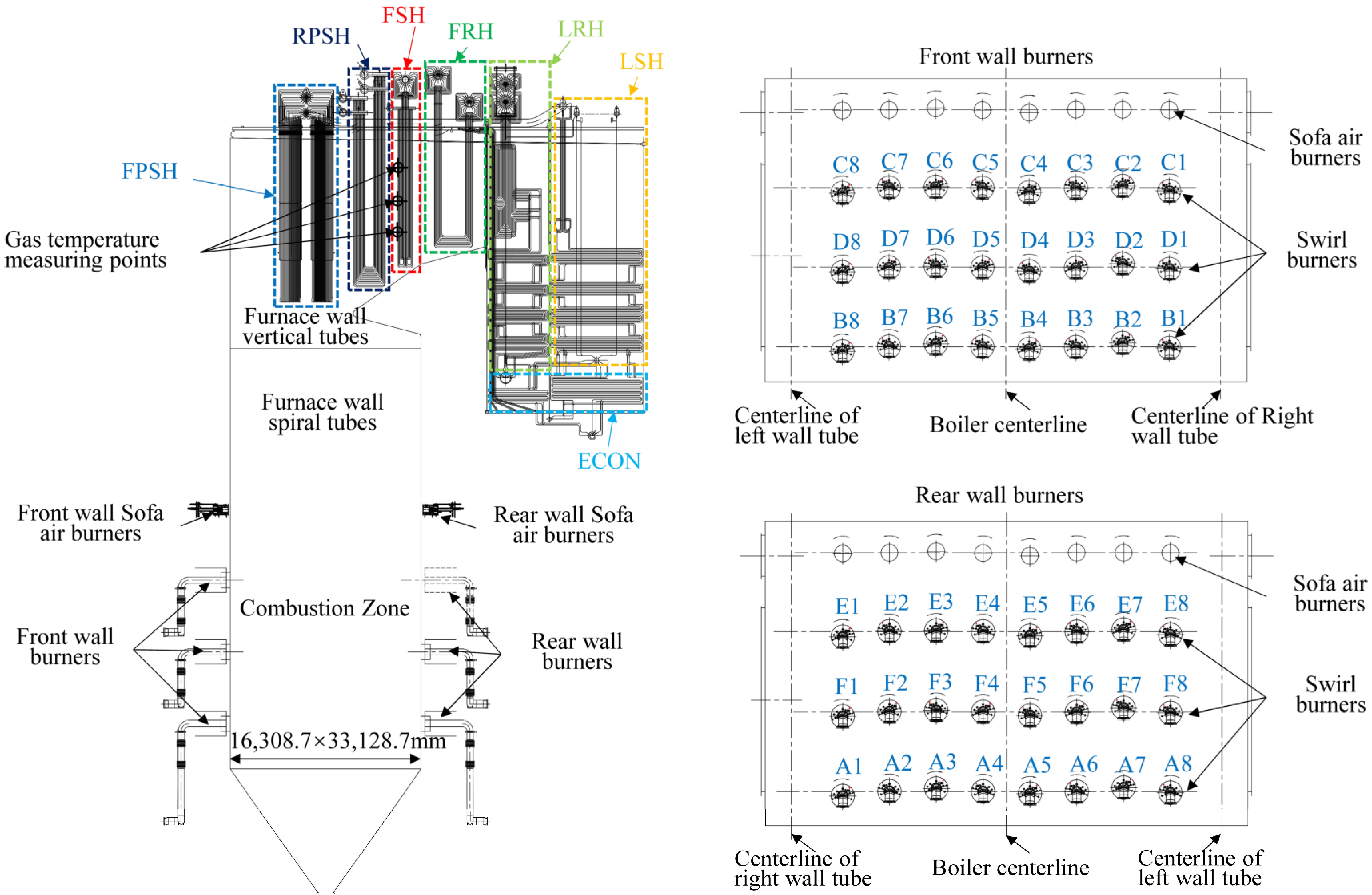
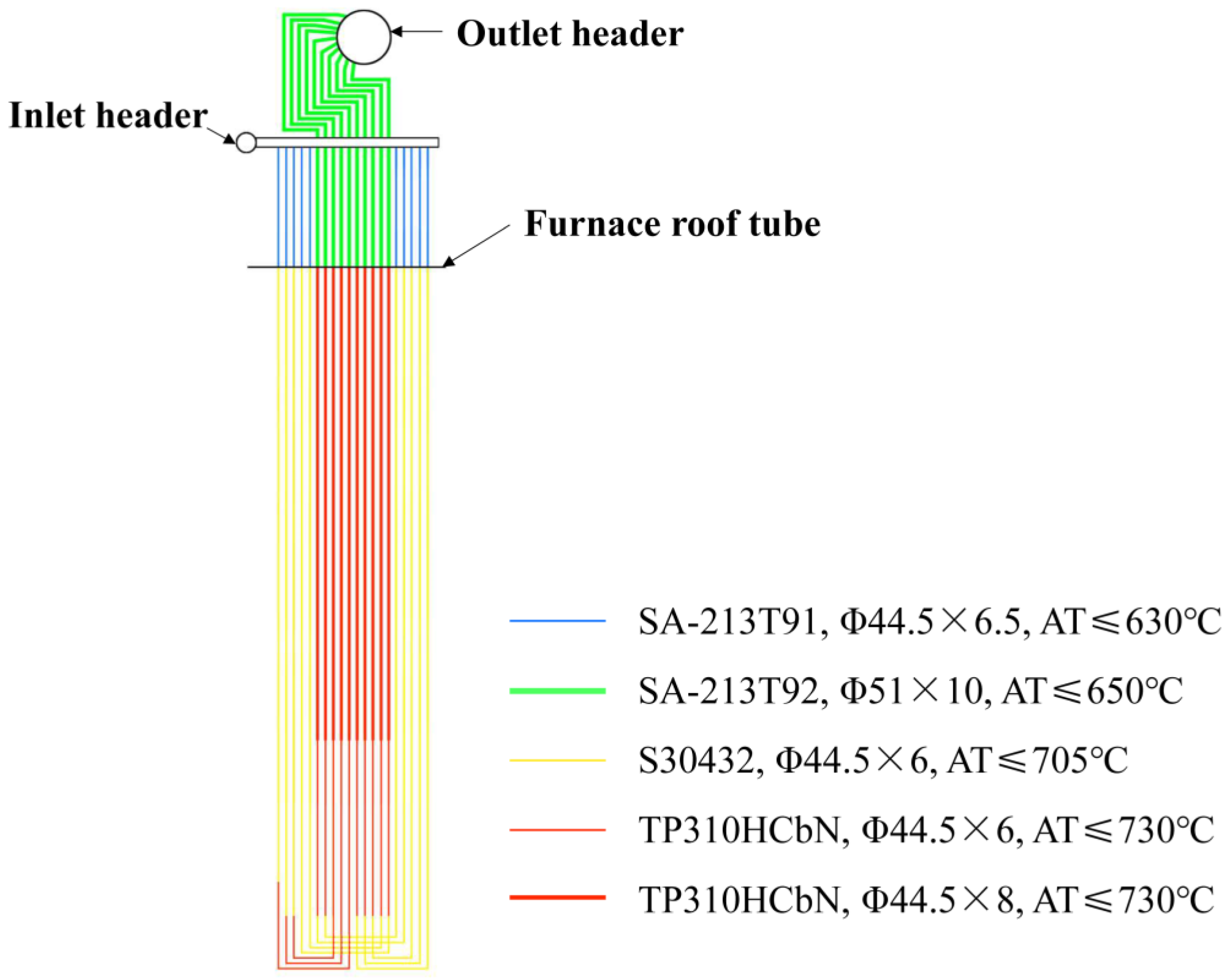
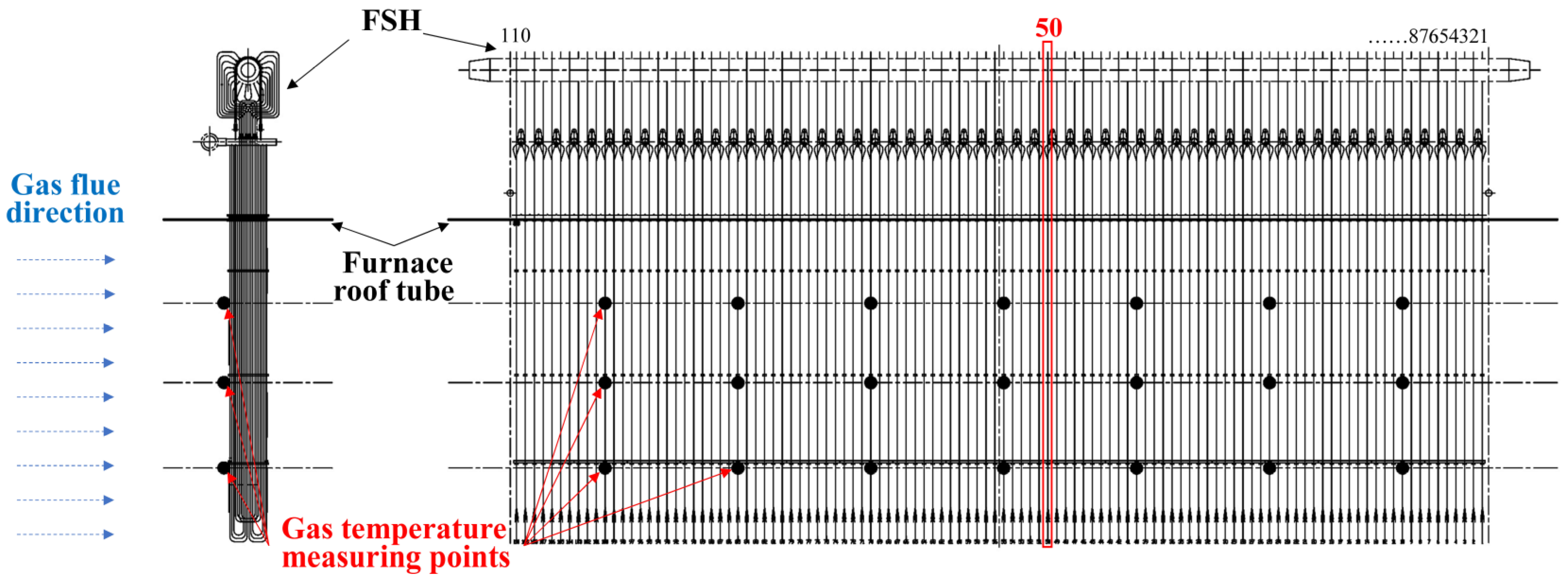
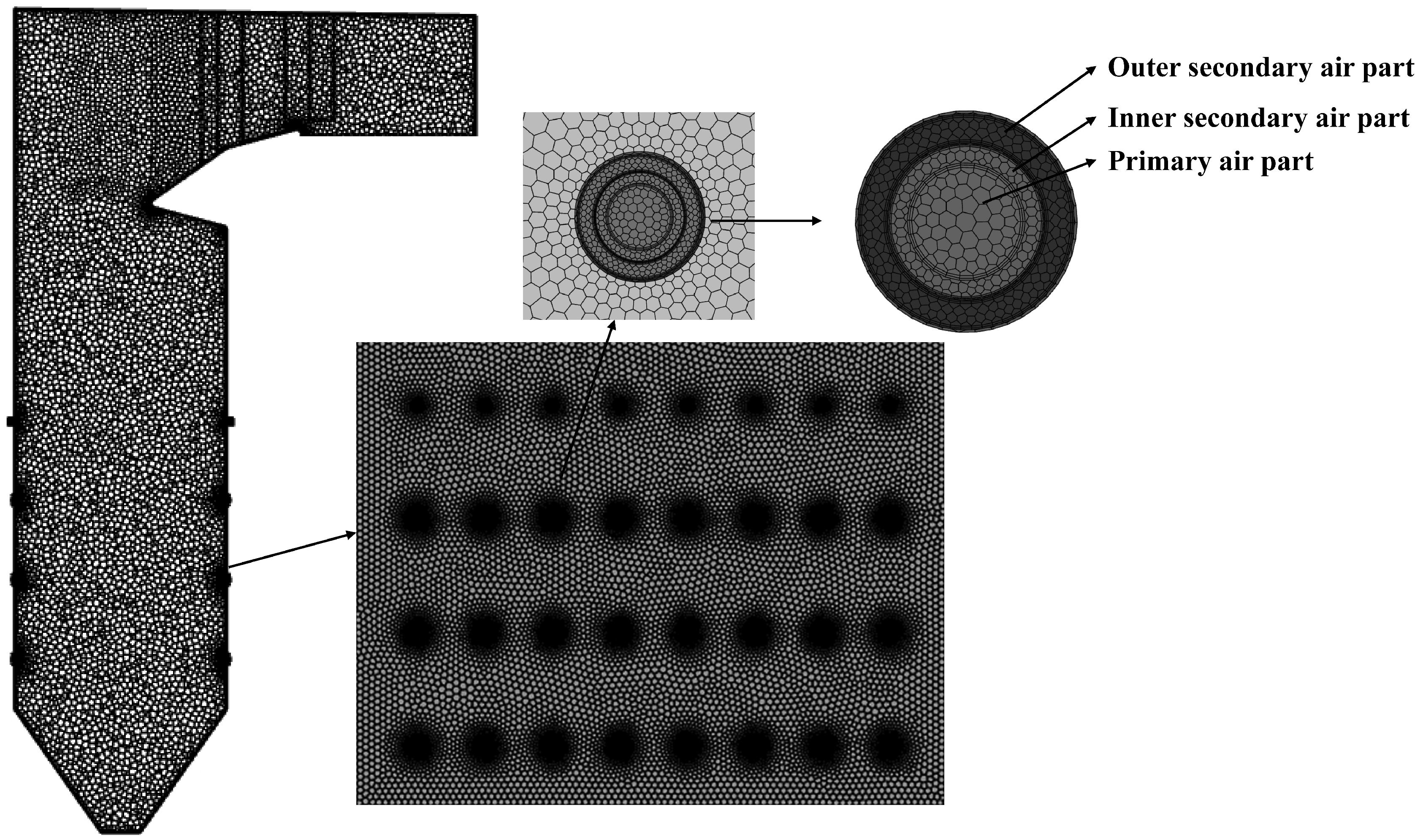
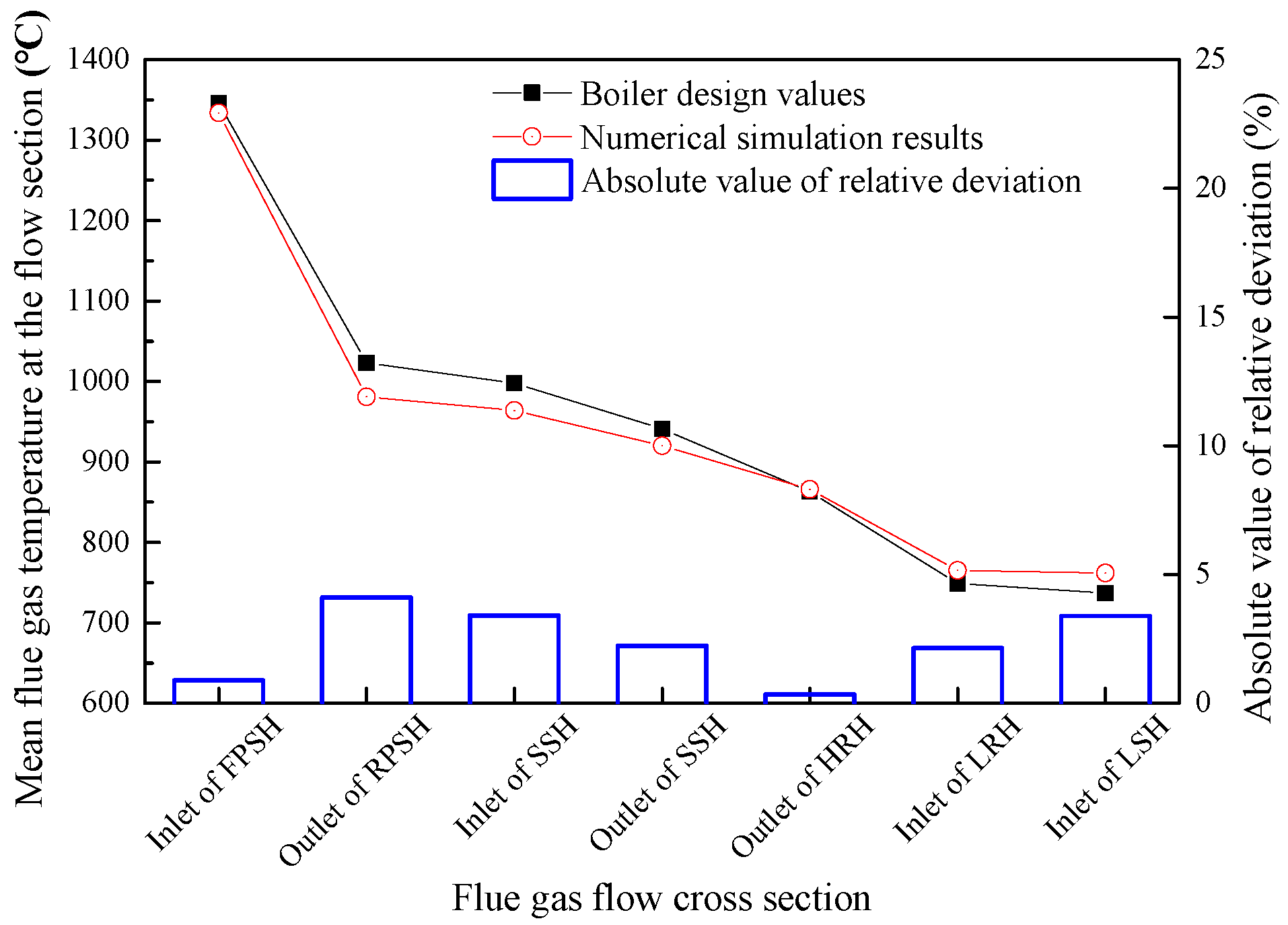
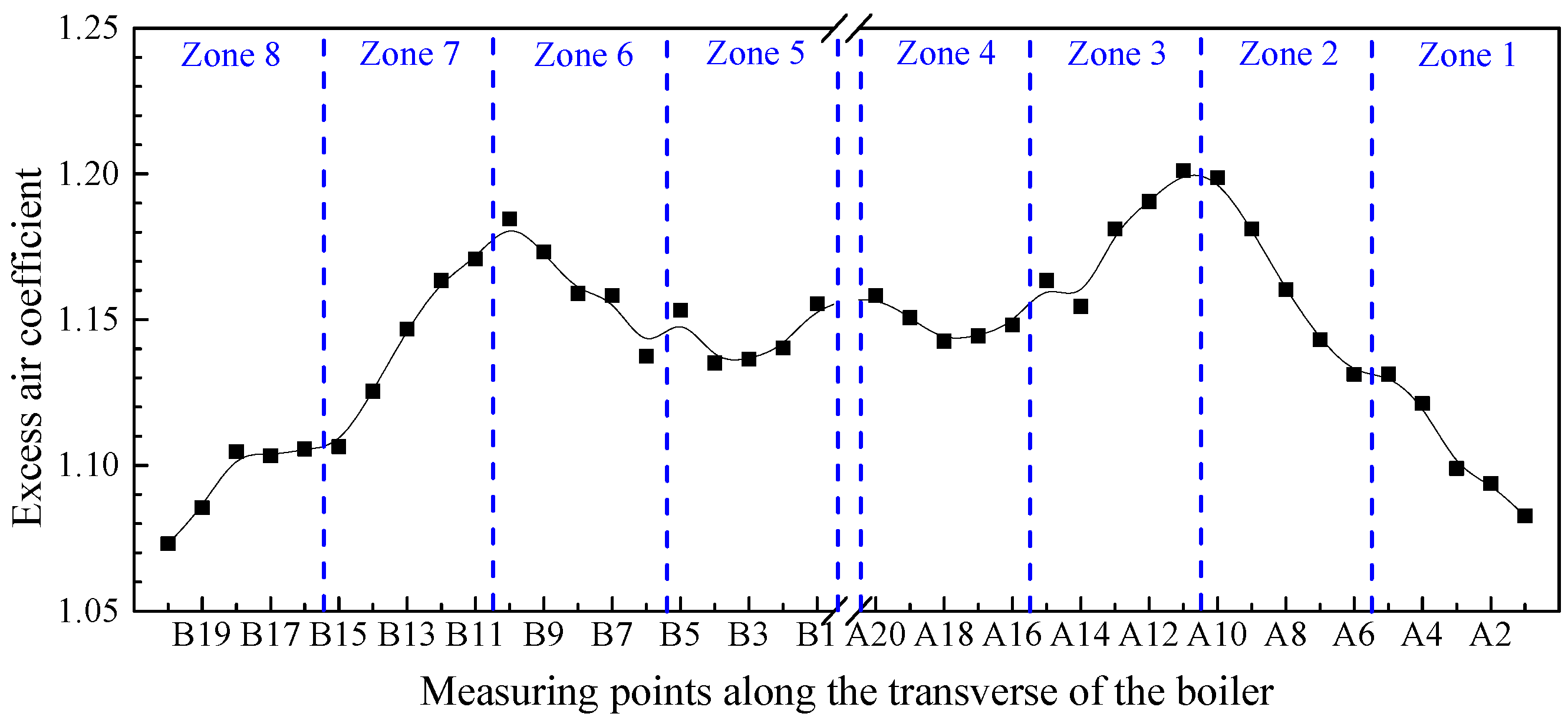
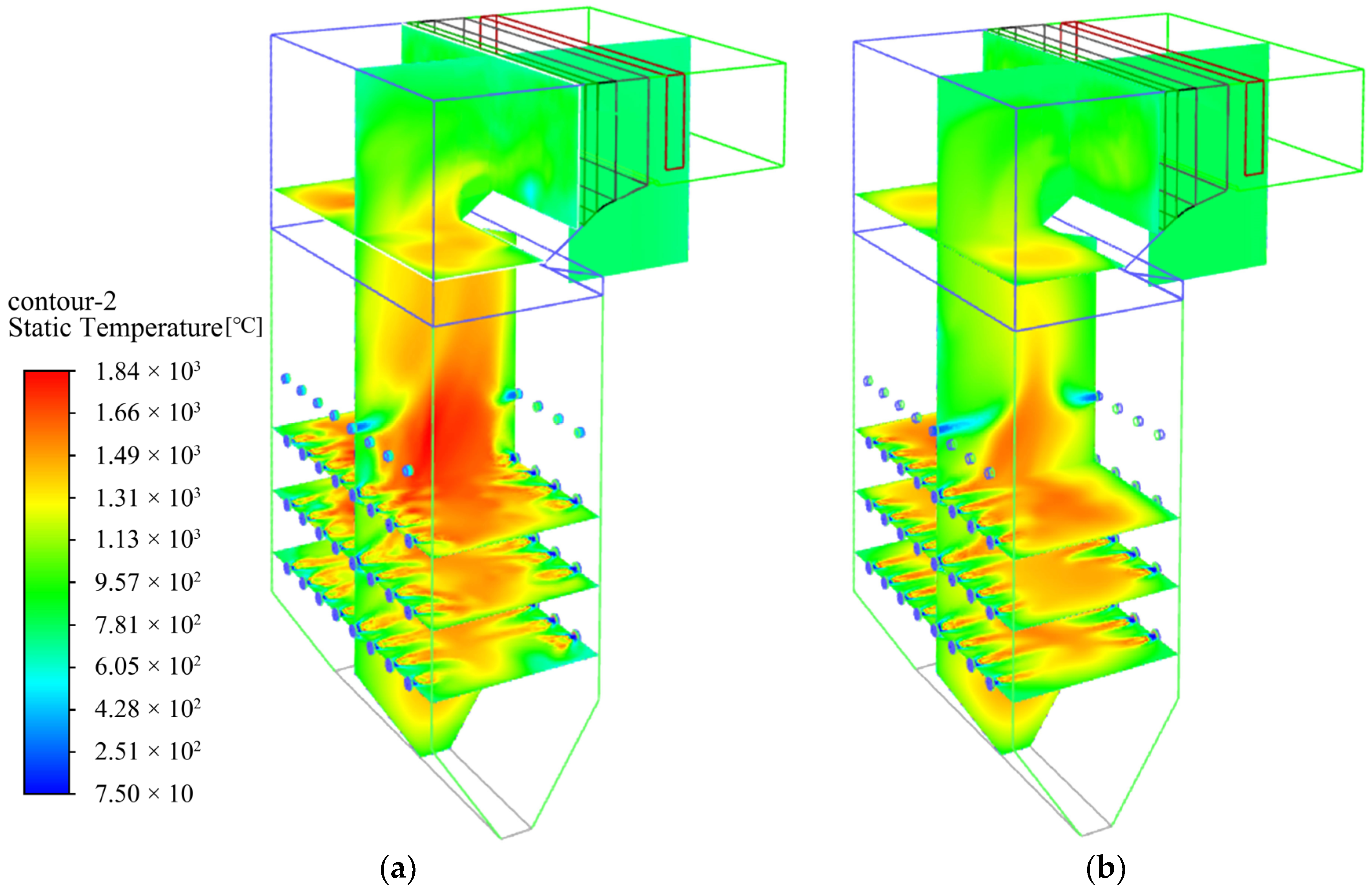

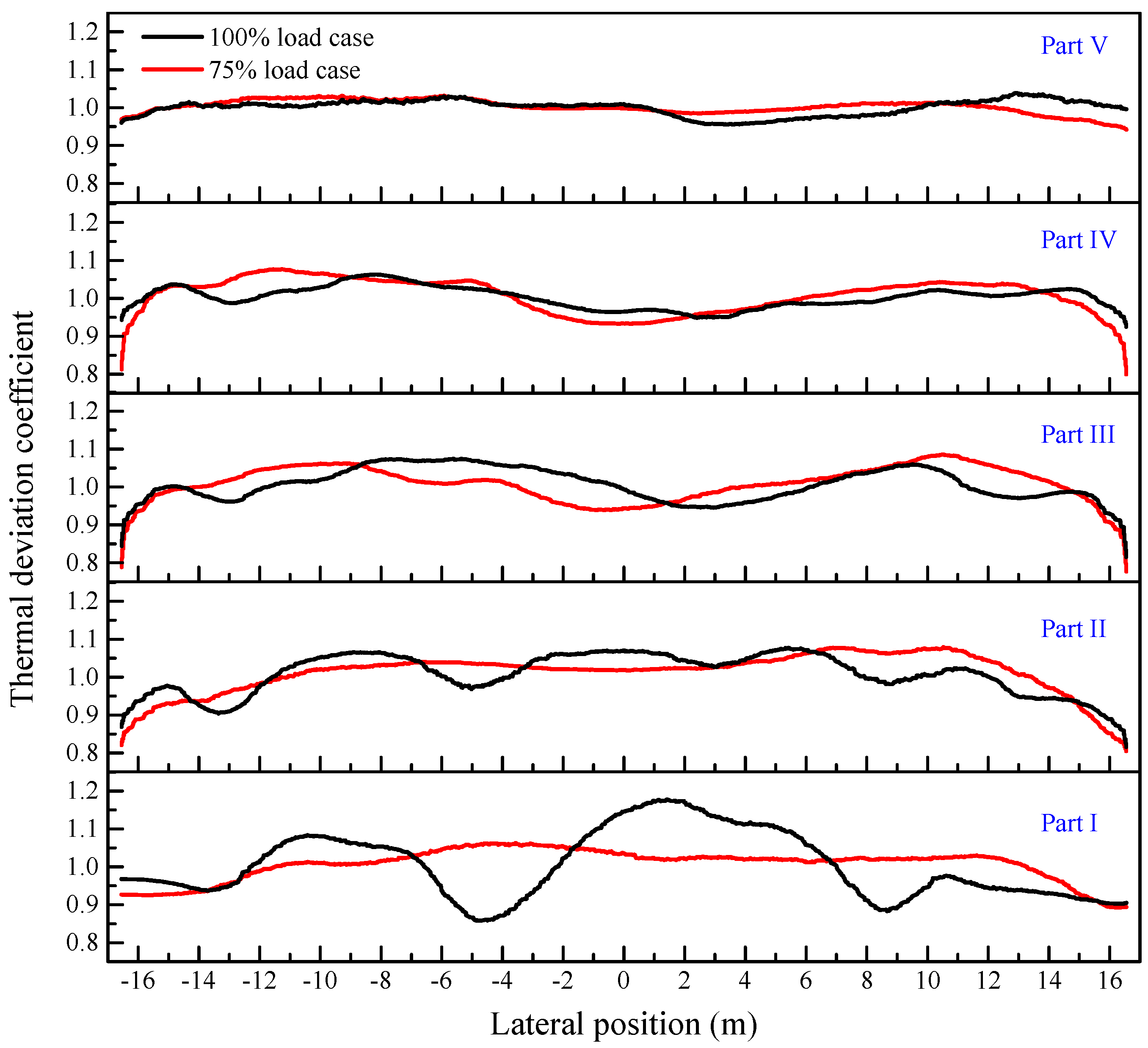
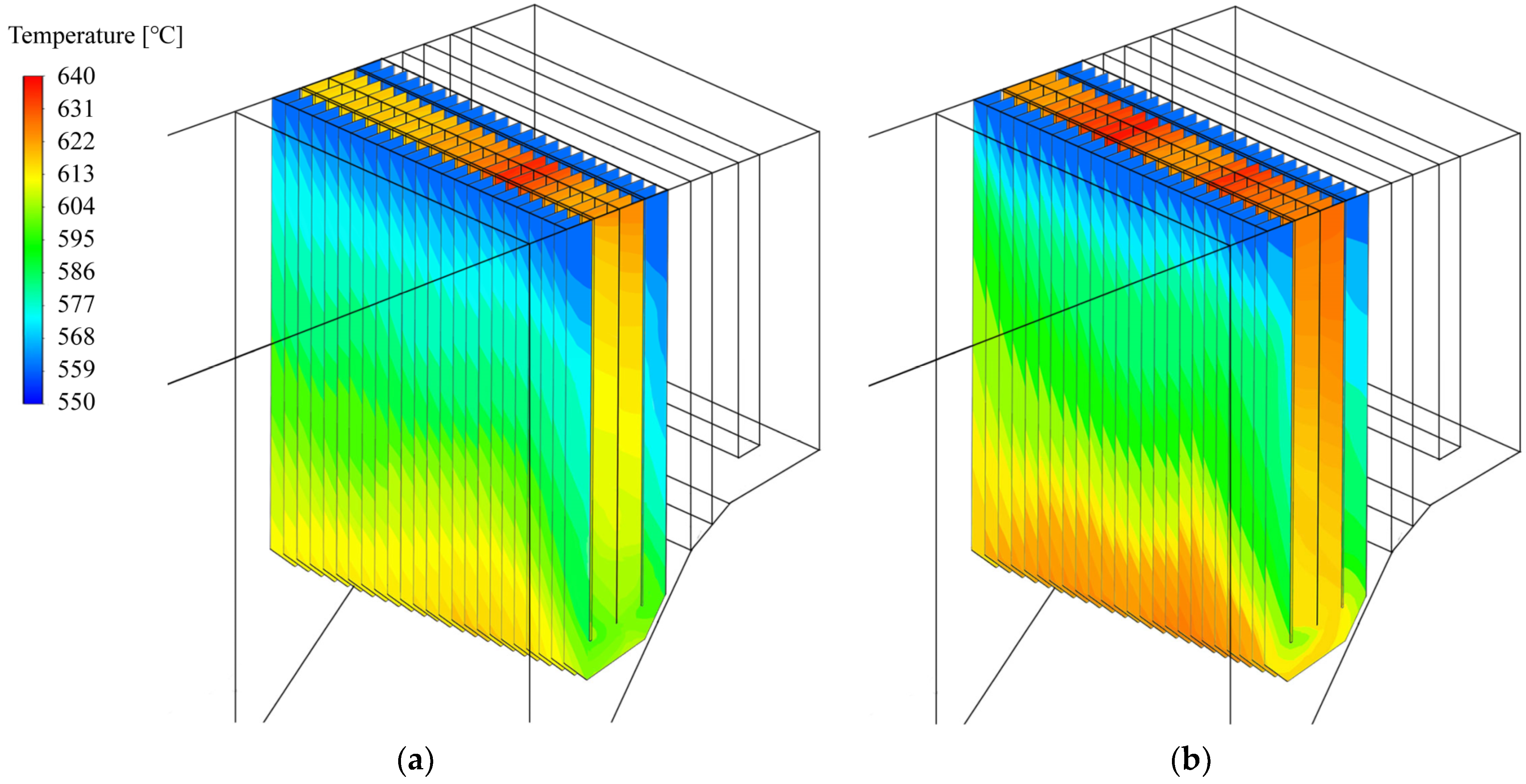
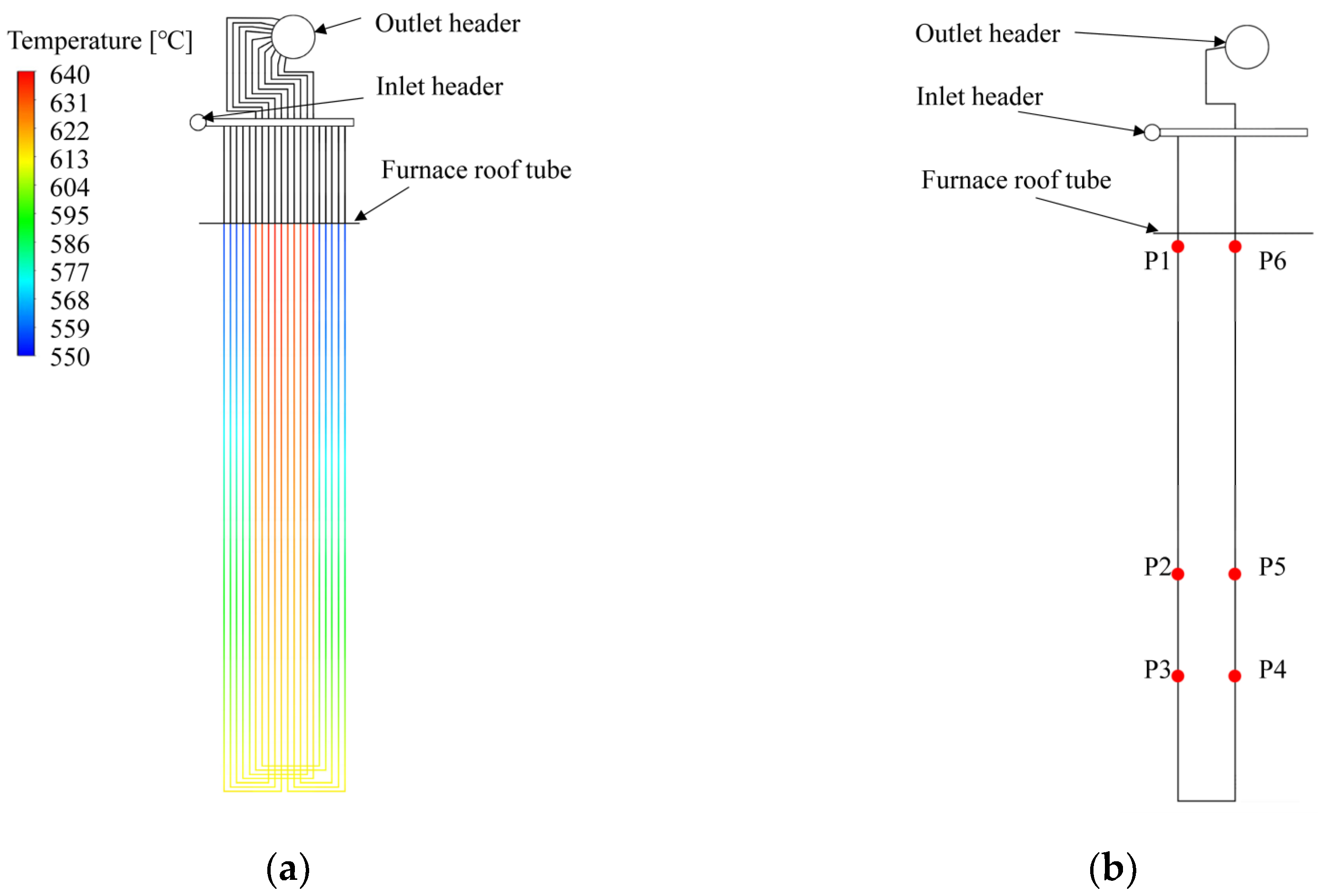

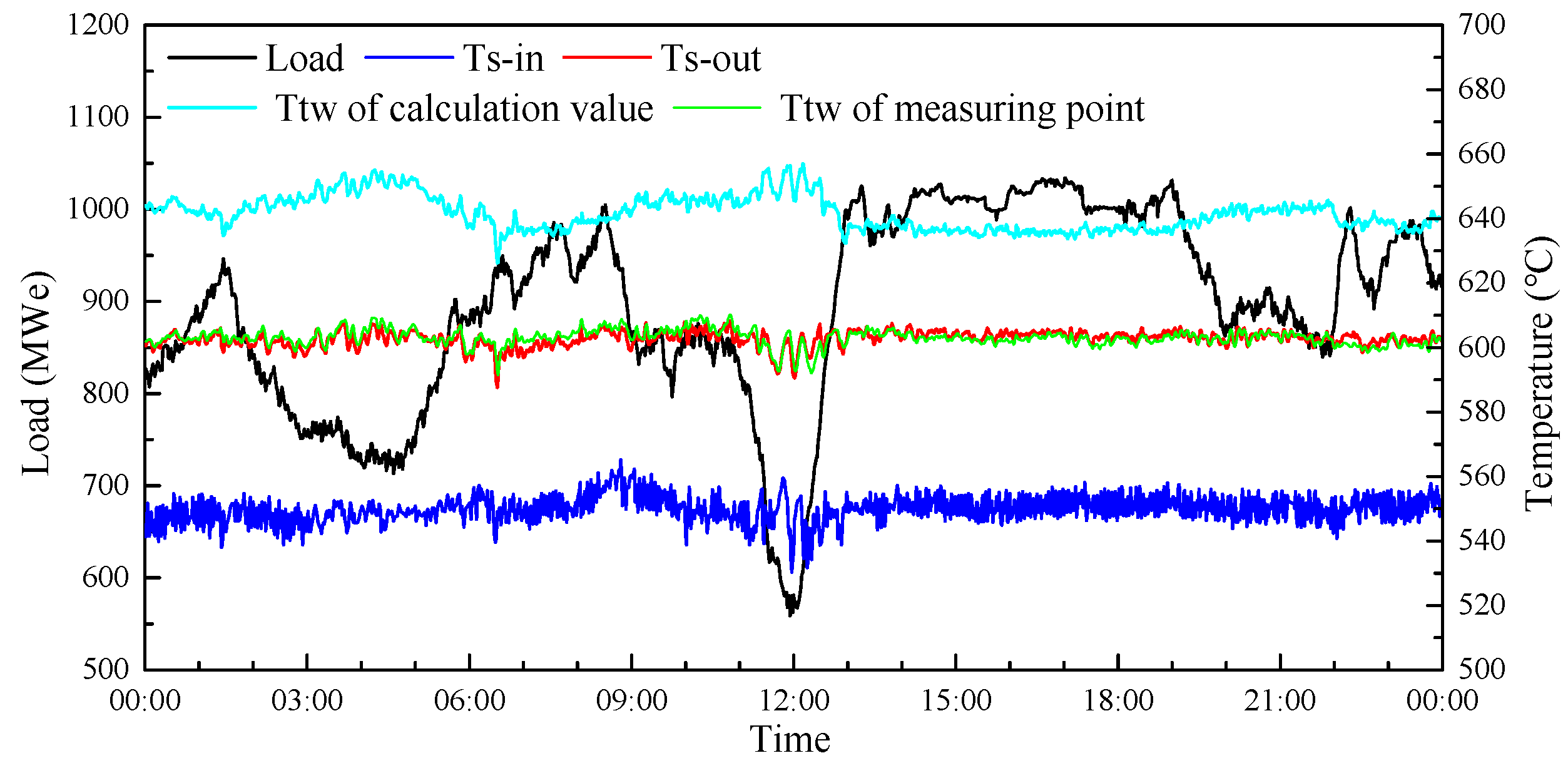
| Parameter | Design Conditions (BMCR) | Actual Operating Condition | |
|---|---|---|---|
| 100% Load | 75% Load | ||
| Mills in service | ABCDE | ABCDEF | ABCDE |
| Total coal flow rate (kg/s) | 106.39 | 95.07 | 71.30 |
| Primary air flow rate (kg/s) | 189.72 | 179.12 | 141.74 |
| Primary air inlet temperature (°C) | 70.0 | 73.8 | 77.2 |
| Secondary air flow rate (kg/s) | 392 | 401 | 327 |
| Secondary air inlet temperature (°C) | 354 | 342 | 328 |
| Inner secondary air rate (%) | 30 | 30 | 30 |
| Outer secondary air rate (%) | 70 | 70 | 70 |
| Sofa air flow rate (kg/s) | 142.6 | 136.1 | 76.3 |
| Sofa air inlet temperature (°C) | 354 | 342 | 328 |
Disclaimer/Publisher’s Note: The statements, opinions and data contained in all publications are solely those of the individual author(s) and contributor(s) and not of MDPI and/or the editor(s). MDPI and/or the editor(s) disclaim responsibility for any injury to people or property resulting from any ideas, methods, instructions or products referred to in the content. |
© 2023 by the authors. Licensee MDPI, Basel, Switzerland. This article is an open access article distributed under the terms and conditions of the Creative Commons Attribution (CC BY) license (https://creativecommons.org/licenses/by/4.0/).
Share and Cite
Li, P.; Bao, T.; Guan, J.; Shi, Z.; Xie, Z.; Zhou, Y.; Zhong, W. Computational Analysis of Tube Wall Temperature of Superheater in 1000 MW Ultra-Supercritical Boiler Based on the Inlet Thermal Deviation. Energies 2023, 16, 1539. https://doi.org/10.3390/en16031539
Li P, Bao T, Guan J, Shi Z, Xie Z, Zhou Y, Zhong W. Computational Analysis of Tube Wall Temperature of Superheater in 1000 MW Ultra-Supercritical Boiler Based on the Inlet Thermal Deviation. Energies. 2023; 16(3):1539. https://doi.org/10.3390/en16031539
Chicago/Turabian StyleLi, Pei, Ting Bao, Jian Guan, Zifu Shi, Zengxiao Xie, Yonggang Zhou, and Wei Zhong. 2023. "Computational Analysis of Tube Wall Temperature of Superheater in 1000 MW Ultra-Supercritical Boiler Based on the Inlet Thermal Deviation" Energies 16, no. 3: 1539. https://doi.org/10.3390/en16031539
APA StyleLi, P., Bao, T., Guan, J., Shi, Z., Xie, Z., Zhou, Y., & Zhong, W. (2023). Computational Analysis of Tube Wall Temperature of Superheater in 1000 MW Ultra-Supercritical Boiler Based on the Inlet Thermal Deviation. Energies, 16(3), 1539. https://doi.org/10.3390/en16031539








